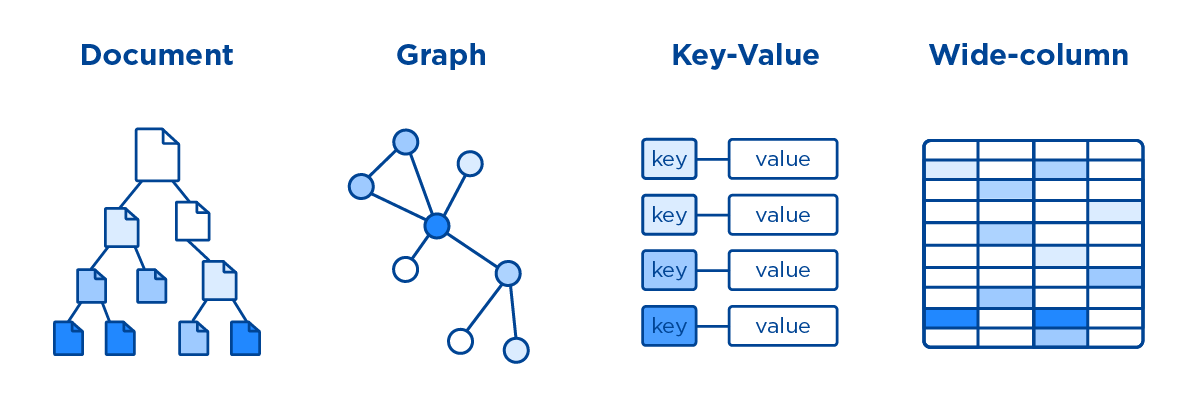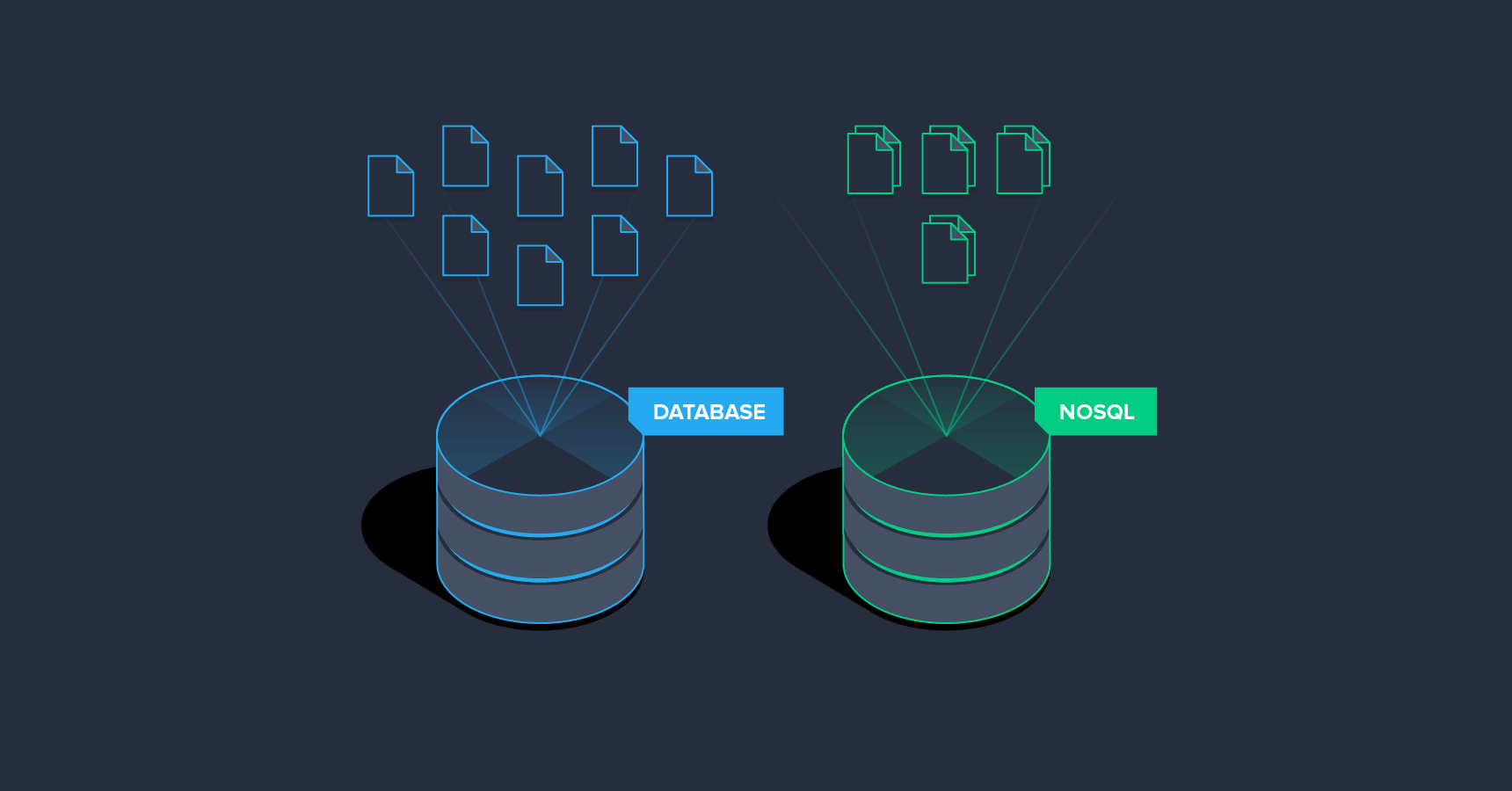 Logicmojo - Updated Jan 11, 2024
Logicmojo - Updated Jan 11, 2024
Large tech firms like Netflix, Hulu, Uber, and Facebook have popularised NoSQL or non-relational databases during the past few years. I'll provide a brief overview of the many kinds of NoSQL databases in this blog article and discuss how they differ from conventional SQL databases.

What is NoSQL DataBase?
Key-value, document, columnar, and graph formats are just a few examples of the many different types of data models that can be supported by the NoSQL approach to database management. In general, a NoSQL database is non-relational, distributed, adaptable, and scalable. In addition, NoSQL databases frequently lack a database schema and offer data clustering, replication, and eventual consistency, as opposed to relational and SQL databases' conventional ACID (atomicity, consistency, isolation, and durability) transaction consistency. A lot of NoSQL database systems are open source as well.
Since SQL wasn't utilised as the API to retrieve data, the term NoSQL could initially be understood literally. However, due to SQL's popularity and usefulness, several NoSQL databases have added support for it. The term "Not Only SQL" (or NoSQL) is now widely adopted.
The four most common types of NoSQL databases are described as follows:
• Document databases: The main purpose of document databases is to store data as documents, including but not limited to JSON documents. For example, these systems can be used to store XML documents.
• key-value databases: For quick retrieval, key-value storing organises group-related data into collections of records with unique keys. Key-value stores provide the advantages of NoSQL while yet having just enough structure to replicate the value of relational databases.
• Wide-column databases: Even within the same table, wide-column databases allow for a great deal of variation in how data is titled and presented in each row. Wide-column databases, like key-value stores, provide some fundamental structure while simultaneously retaining a great deal of flexibility.
• Graph database: The relationships between the data points recorded in graph databases are defined by the graph structures. For finding patterns in unstructured and semi-structured data, graph databases are helpful.

History of NoSQL
The advent of NoSQL databases coincided with a sharp decline in storage costs in the late 2000s. The days of having to build a complicated, challenging data model in order to prevent data duplication are long gone. NoSQL databases were designed with developer productivity in mind because developers (and not storage) were starting to represent the majority of the expense of developing software.
The amount of data that applications required to store and query expanded as storage costs dropped quickly. This data came in a variety of formats, including structured, semi-structured, and polymorphic, making it practically difficult to define the schema beforehand. NoSQL databases give programmers a great deal of freedom by enabling them to store enormous amounts of unstructured data.
With the rise in popularity of cloud computing, developers started leveraging public clouds to host their applications and data. To make their applications resilient, scale out rather than scale up, and intelligently geo-place their data, they desired the capability to spread data across various servers and locations. These features are offered by some NoSQL databases like MongoDB.
Why use NoSQL?
Customer experience has quickly emerged as the key competitive difference, ushering in a period of profound transformation for the commercial sector. As a result of this shift, businesses are engaging in new levels of digital interaction with not only their consumers but also their partners, workers, vendors, and even their own goods. The internet and other 21st-century technologies power this contact, and the cloud, mobile, social media, big data, and Internet of Things (IoT) applications of a corporation are at the centre of the transformation.
What distinguishes these applications from dated enterprise software like ERP, HR, and financial accounting? The following traits are shared by most (if not all) modern online, mobile, and IoT apps. They should:
• Support several users operating simultaneously (tens of thousands, perhaps millions)
• Deliver incredibly responsive user experiences to a worldwide user base.
• Always be accessible; never go offline
• Utilize semi-structured and unstructured data
• Through frequent upgrades and new features, quickly react to changing requirements
Advantages & Disadvantages of NoSQL
Working with NoSQL databases like MongoDB and Cassandra has several benefits. High availability and scalability are the key benefits.
Scalability: Sharding is a method for horizontal scaling in NoSQL databases. Sharding is the process of partitioning data and distributing it across a number of computers while maintaining the data's original arrangement. In contrast to horizontal scaling, which involves adding more machines to handle the data, vertical scaling is adding more resources to the present machine. Implementing vertical scaling is difficult, while doing so with horizontal scaling is simple. MongoDB, Cassandra, and other databases with horizontal scaling are examples. Due to its ability to scale, NoSQL can handle large amounts of data and do so in an effective manner as the amount of data increases.
Availability: Because data replicates itself to the prior consistent state in case of failure, NoSQL databases provide a high level of availability.
Big data, cloud, mobile, social media, and other requirements are better suited for NoSQL databases.
Disadvantages:
• Each NoSQL database has a unique syntax for data management and querying. In contrast, SQL, the common language of relational and SQL database systems, is used.
• The data integrity protections that are included in relational and SQL database systems are removed when there is a lack of a tight database schema and constraints.
• To use the data, a schema with some kind of organisation is necessary. With NoSQL, the application developer must handle this instead of the database administrator.
• They do not offer the same level of data consistency as SQL databases because the majority of NoSQL databases use the eventual consistency paradigm. The data will occasionally be inconsistent, making them unsuitable for activities that need rapid integrity, including banking and ATM transactions.
• There aren't as many thorough industry standards for NoSQL databases as there are for relational and SQL DBMS options because they are more recent.
NoSQL vs SQL
| SQL | NoSQL |
|---|---|
| System software called SQL databases facilitates the management, analysis, capture, and querying of structured data in a relational manner. | A type of software called a no-SQL database enables the maintenance and retrieval of structured, unstructured, and polymorphic data for various purposes. |
| a language for storing, deleting, updating, inserting, and retrieving data from databases. | a application to access databases and manage their scalability. |
| Structured Query Languages are supported by SQL databases. | There is no declarative query language in nonSQL. |
| Supports table based data type. | supports key-value pair-based, graph databases, and document-oriented databases. |
| The storing of data hierarchically is not supported by SQL. | The best database for storing hierarchical data is NoSQL. |
| Predefined schemas are supported by SQL, limiting the storing of data to just structured types. | Dynamic schemas are supported by Nosql for storing various types of data. |
| The ACID (atomicity, consistency, isolation, and durability) qualities are supported by SQL. | The CAP (consistency, availability, partition tolerance) principles apply to non-SQL. |
| SQL databases do not adhere to data dissemination because they can only be run on a single system. | The design of NoSQL databases incorporates data distribution aspects like repetition and partition. |
When to use NoSQL?
NoSQL databases do not need to be as structured as SQL databases and can store a variety of data types. As a result, non-relational databases are more flexible and adaptable, giving them a better option for managing vast amounts of unstructured and unrelated data.
Generally speaking, a NoSQL database is a better choice the bigger the dataset. Non-relational databases typically excel at meeting scalability and availability needs, making them perfect for real-time applications like instant messaging and social networks.
You need to know programming to use NoSQL databases. NoSQL databases typically require someone with an experience in coding and the capacity to pick up additional languages depending on the database systems being used, unlike SQL, which can easily be learnt by people from other industries like management and marketing.
NoSQL Use Cases
Your organization's intended usage for the database will determine its structure and kind. Here are some specific applications for various NoSQL database types.
Managing data relationships: A graph-based NoSQL database is often used to manage the complicated aggregation of data and the links between these points. Using diverse data kinds, linkages between people are established in social networks, knowledge graphs, fraud detection software, and recommendation engines.
Performance with low latency: Real-time data handling calls for high throughput in the gaming, home fitness, and ad tech industries. Whether it's market bidding updates or returning the most pertinent advertisements, this infrastructure offers the consumer the most value. In order to provide quick response times and handle demand spikes without the lag that disc storage might cause, web applications need in-memory NoSQL databases.
Scaling and high data volumes: Whether it's for a one-day sale or the Christmas shopping season, e-commerce needs to be able to handle huge surges in usage. Because of their straightforward structure, key-value databases are commonly employed in e-commerce systems. This allows for easy scaling up during periods of high traffic. Applications in the gaming, adtech, and Internet of Things (IoT) industries can benefit from this adaptability.
In this article, we went through the fundamentals of a NoSQL DataBase and identified its main advantages and disadvantages.
Good luck and happy learning!






